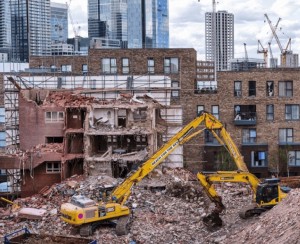Whether it is residential or commercial architecture, for a long time the process has been linear. What we did was extract raw materials, build structures with them, demolish when they were no longer useful, and dispose of the materials in landfill. However, there are a whole host of issues here. It can be incredibly harmful to the environment and wastes resources.
Luckily, the classic approach is no longer acceptable in many areas. Consumers, businesses, and governments are all looking at more sustainable alternatives. This can include reuse and recycling. Ultimately, the goal should be to ensure a circular use of resources with little to no materials going to waste.
How does deconstruction help?
 A great idea here is to choose deconstruction instead of demolition. Traditionally the goal was to demolish buildings quickly to speed up the regeneration. There was very little thought to the process, as long as it was safe. Massive plant like bulldozers and wrecking balls would simply reduce it all to rubble and then the waste would be taken away to dump.
A great idea here is to choose deconstruction instead of demolition. Traditionally the goal was to demolish buildings quickly to speed up the regeneration. There was very little thought to the process, as long as it was safe. Massive plant like bulldozers and wrecking balls would simply reduce it all to rubble and then the waste would be taken away to dump.
Deconstruction is a slower, more careful process. It involves contractors carefully breaking down the structures, preserving the materials as they do. As a result, bricks, glass, timber, metals, and more can all be set aside for reuse or recycling. Keeping them separate ensures there are no issues like cross contamination. It can be a great option for all kinds of buildings, including commercial architecture and homes.
Some examples from the US
Several cities in the US support the move to deconstruction and now have ordinance to mandate it instead of demolition. Let’s look at some of them.
The first city to embrace deconstruction was Portland, Oregon. Back in 2016 they made the decision that pre-1940 single family homes should be deconstructed, saving the materials to reuse. Three years later they chose to expand the mandate to cover all houses and duplexes. As a result, every year Oregon saves over 2,200 tonnes of materials.
Boulder, Colorado has one of the most impressive approaches to deconstruction. It is mandatory for every building, whatever the age or use, including commercial architecture. More importantly, there is a minimum material diversion target. This means that every project must keep at least 75% of a building’s weight from landfill. So, there are strict requirements for reuse and recycling.
Seattle, Washington has a number of rules for the deconstruction of residential properties. Firstly, 100% of concrete, asphalt and brick must be recycled or reused. A minimum of 50% of other materials should go for recycling. Plus, a minimum of 20% of materials should be for reuse. There is even more criteria for historic landmarks.
Finally, we have Pittsburgh, Pennsylvania. They are trialling deconstruction with ordinances and initiatives for condemned properties owned by the city. The goal is to ensure material recovery, keep waste from landfill, and reduce greenhouse gas emissions.
Get help with commercial architecture
At Coffey Architects we have a lot of experience with developing commercial buildings. We can look at the best option for each property, finding a solution that will work for the users and the environment. Creative designs can focus on reuse and recycling. In fact, they can often produce the most incredible results, especially when there are original materials or heritage features.
So, if you need some help to develop commercial architecture, speak to us. We are based in London but do projects around the world.